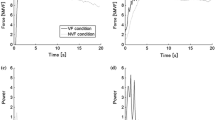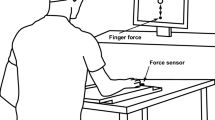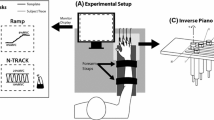Abstract
This study examined the effects of handedness on the inter-digit coordination of force variability with and without concurrent visual feedback during sustained precision pinch. Twenty-four right-handed subjects were instructed to pinch an instrumented apparatus with their dominant and non-dominant hands, separately. During the pinch, the subjects were required to maintain a stable force output at 5 N for 1 min. Visual feedback was given for the first 30 s and removed for the second 30 s. Coefficient of variation and detrended fluctuation analysis were employed to examine the amount and structural variability of the thumb and index finger forces. Similarly, correlation coefficient and detrended cross-correlation analysis were applied to quantify the inter-digit correlation of force amount and structural variability. Results showed that, compared to the non-dominant hand, the dominant hand had higher inter-digit difference in the amount of digit force variability. Without visual feedback, the dominant hand exhibited lower digit force structural variability but higher inter-digit force structural correlation than the non-dominant hand. These results implied that the dominant hand would be more independent, less flexible and with lower dynamic degrees of freedom than the non-dominant hand in coordination of the thumb and index finger forces during sustained precision pinch. The effects of handedness on inter-digit force coordination were dependent on sensory condition, which shed light on higher-level sensorimotor mechanisms that may be responsible for the asymmetries in coordination of digit force variability.





Similar content being viewed by others
References
Adam A, De Luca CJ, Erim Z (1998) Hand dominance and motor unit firing behavior. J Neurophysiol 80:1373–1382
Adamo DE, Taufiq A (2011) Establishing hand preference: Why does it matter? Hand (N Y) 6:295–303. doi:10.1007/s11552-011-9324-x
Aimonetti JM, Morin D, Schmied A, Vedel JP, Pagni S (1999) Proprioceptive control of wrist extensor motor units in humans: dependence on handedness. Somatosens Mot Res 16:11–29
Boulinguez P, Nougier V, Velay JL (2001) Manual asymmetries in reaching movement control. I: study of right-handers. Cortex: J Devoted Study Nerv Syst Behav 37:101–122
Bradshaw JL, Nettleton NC, Taylor MJ (1981) The use of laterally presented words in research into cerebral asymmetry: is directional scanning likely to be a source of artifact? Brain Lang 14:1–14
Deutsch KM, Newell KM (2002) Children’s coordination of force output in a pinch grip task. Dev Psychobiol 41:253–264. doi:10.1002/dev.10051
Deutsch KM, Newell KM (2003) Deterministic and stochastic processes in children’s isometric force variability. Dev Psychobiol 43:335–345
Dun S, Kaufmann RA, Li ZM (2007) Lower median nerve block impairs precision grip. J Electromyogr Kinesiol 17:348–354. doi:10.1016/j.jelekin.2006.02.002
Fuglevand AJ, Winter DA, Patla AE (1993) Models of recruitment and rate coding organization in motor-unit pools. J Neurophysiol 70:2470–2488
Fugl-Meyer AR, Eriksson A, Sjostrom M, Soderstrom G (1982) Is muscle structure influenced by genetical or functional factors? A study of three forearm muscles. Acta Physiol Scand 114:277–281. doi:10.1111/j.1748-1716.1982.tb06983.x
Goble DJ, Brown SH (2008) The biological and behavioral basis of upper limb asymmetries in sensorimotor performance. Neurosci Biobehav Rev 32:598–610. doi:10.1016/j.neubiorev.2007.10.006
Goble DJ, Lewis CA, Brown SH (2006) Upper limb asymmetries in the utilization of proprioceptive feedback. Exp Brain Res 168:307–311. doi:10.1007/s00221-005-0280-y
Goodale MA (1988) Hemispheric differences in motor control. Behav Brain Res 30:203–214
Hammond G (2002) Correlates of human handedness in primary motor cortex: a review and hypothesis. Neurosci Biobehav Rev 26:285–292
Honda H (1982) Rightward superiority of eye movements in a bimanual aiming task. Q J Exp Psychol A Human Exp Psychol 34:499–513
Honda H (1984) Functional between-hand differences and outflow eye position information. Q J Exp Psychol A Human Exp Psychol 36:75–88
Hoshiyama M, Kakigi R (1999) Changes of somatosensory evoked potentials during writing with the dominant and non-dominant hands. Brain Res 833:10–19
Kimura D (1982) Left-hemisphere control of oral and brachial movements and their relation to communication. Philos Trans R Soc Lond B Biol Sci 298:135–149
Li K, Li ZM (2013) Cross recurrence quantification analysis of precision grip following peripheral median nerve block. J Neuroeng Rehabil 10:28. doi:10.1186/1743-0003-10-28
Li K, Marquardt TL, Li ZM (2013a) Removal of visual feedback lowers structural variability of inter-digit force coordination during sustained precision pinch. Neurosci Lett 545:1–5. doi:10.1016/j.neulet.2013.04.011
Li K, Nataraj R, Marquardt TL, Li ZM (2013b) Directional coordination of thumb and finger forces during precision pinch. PLoS ONE 8:e79400. doi:10.1371/journal.pone.0079400
Li K, Evans PJ, Seitz WH Jr, Li ZM (2015) Carpal tunnel syndrome impairs sustained precision pinch performance. Clin Neurophysiol 126:194–201. doi:10.1016/j.clinph.2014.05.004
Lindsay TR, Noakes TD, McGregor SJ (2014) Effect of treadmill versus overground running on the structure of variability of stride timing. Percept Mot Skills 118:331–346. doi:10.2466/30.26.PMS.118k18w8
Mieschke PE, Elliott D, Helsen WF, Carson RG, Coull JA (2001) Manual asymmetries in the preparation and control of goal-directed movements. Brain Cogn 45:129–140. doi:10.1006/brcg.2000.1262
Moritz CT, Barry BK, Pascoe MA, Enoka RM (2005) Discharge rate variability influences the variation in force fluctuations across the working range of a hand muscle. J Neurophysiol 93:2449–2459. doi:10.1152/jn.01122.2004
Newell KM, Broderick MP, Deutsch KM, Slifkin AB (2003) Task goals and change in dynamical degrees of freedom with motor learning. J Exp Psychol Hum Percept Perform 29:379–387
Ofori E, Samson JM, Sosnoff JJ (2010) Age-related differences in force variability and visual display. Exp Brain Res 203:299–306. doi:10.1007/s00221-010-2229-z
Oldfield RC (1971) The assessment and analysis of handedness: the Edinburgh inventory. Neuropsychologia 9:97–113
Peng CK, Havlin S, Stanley HE, Goldberger AL (1995) Quantification of scaling exponents and crossover phenomena in nonstationary heartbeat time series. Chaos 5:82–87. doi:10.1063/1.166141
Podobnik B, Stanley HE (2008) Detrended cross-correlation analysis: a new method for analyzing two nonstationary time series. Phys Rev Lett 100:084102
Reilly KT, Hammond GR (2000) Independence of force production by digits of the human hand. Neurosci Lett 290:53–56
Reilly KT, Hammond GR (2004) Human handedness: is there a difference in the independence of the digits on the preferred and non-preferred hands? Exp Brain Res 156:255–262. doi:10.1007/s00221-003-1783-z
Reilly KT, Hammond GR (2006) Intrinsic hand muscles and digit independence on the preferred and non-preferred hands of humans. Exp Brain Res 173:564–571. doi:10.1007/s00221-006-0397-7
Schmied A, Vedel JP, Pagni S (1994) Human spinal lateralization assessed from motoneurone synchronization: dependence on handedness and motor unit type. The Journal of physiology 480(Pt 2):369–387
Semmler JG, Nordstrom MA (1995) Influence of handedness on motor unit discharge properties and force tremor. Exp Brain Res 104:115–125
Vaillancourt DE, Russell DM (2002) Temporal capacity of short-term visuomotor memory in continuous force production. Exp Brain Res 145:275–285. doi:10.1007/s00221-002-1081-1
Vaillancourt DE, Slifkin AB, Newell KM (2001) Regularity of force tremor in Parkinson’s disease. Clin Neurophysiol 112:1594–1603
Vaillancourt DE, Slifkin AB, Newell KM (2002) Inter-digit individuation and force variability in the precision grip of young, elderly, and Parkinson’s disease participants. Mot Control 6:113–128
Acknowledgments
This research was supported by China–Australia Centre for Health Sciences Research, National Natural Science Foundation of China (31200744), China Postdoctoral Science Foundation (2014M560558), Postdoctoral Innovation Foundation of Shandong Province (201401012), Promotive Research Fund for Young and Middle-aged Scientists of Shandong Province (BS2011DX018), Science Foundation of Qilu Hospital of Shandong University and Scientific Research Foundation for Returned Scholars by Ministry of Education of China.
Conflict of interest
The authors declare that they have no conflict of interest.
Author information
Authors and Affiliations
Corresponding author
Additional information
Ke Li and Na Wei have contributed equally to this publication.
Rights and permissions
About this article
Cite this article
Li, K., Wei, N., Yue, S. et al. Coordination of digit force variability during dominant and non-dominant sustained precision pinch. Exp Brain Res 233, 2053–2060 (2015). https://doi.org/10.1007/s00221-015-4276-y
Received:
Accepted:
Published:
Issue Date:
DOI: https://doi.org/10.1007/s00221-015-4276-y




